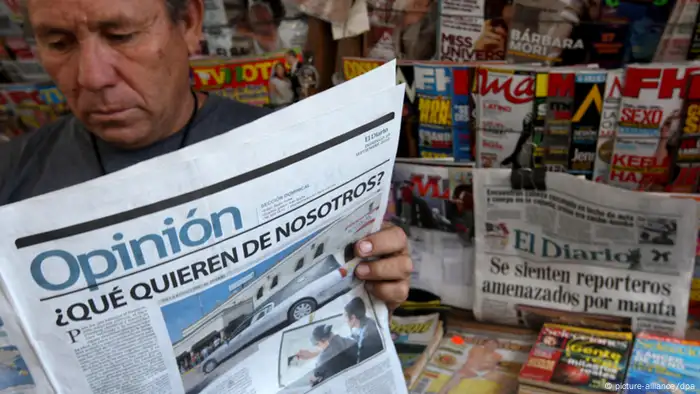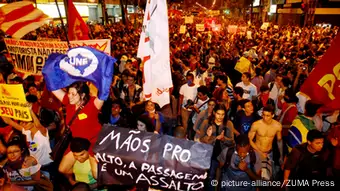Insights
Latin America: A new media development from below
Much of Latin America's private media is in the hands of powerful elites and state-owned media are often government mouthpieces. What is needed is transparent public media and a focus on new communication initiatives.
When we look at media systems in Latin America, we can identify two models reflecting the relationship between the media, politics and civil society in the region's various countries.
Firstly, there is the neoliberal model which is dominated by privatization and corporate concentration and control. This model is present in Central America, Chile and Peru and, to a large extent, also in Brazil and Argentina. In these countries, the media are under the control of the corporate sector, which thanks to their ties to governments and elites, use their ability to influence public opinion as capital. At the same time, these corporate owners closely watch their audiences, which makes them sensitive to changes in public opinion and civil society movements.
Secondly, we can identify new progressive post-neoliberal regimes, such as Ecuador, Bolivia and Venezuela. These regimes reassert the role of the state and embark on new redistributive programs. They want to improve and 'democratize' the media regulatory framework. At the same time, these governments are strongly ideological and do not like criticism. This leads to tensions with the media and public state pressure on media and journalists.
Both of these systems present clear challenges to a pluralistic and open media landscape. Even though there is no explicit censorship or repression of the media, the regulatory framework is often used in arbitrary ways to further political interests or silence criticism. Governments use their (large) advertising budgets to pressure the media into supporting their policies. Journalists are not always well trained and are poorly protected against intimidation and political pressure. Intolerant and sometimes authoritarian governments do not wish to be held accountable. In addition, the corporate sector is often too powerful to touch. The continued influence of the state, combined with media ownership by powerful elites, leads to dependent journalism and self-censorship.
Public media for the public, not for the president

Mexican Grupo Televisa are one of the many influential corporate media groups dominating Latin America
What is lacking in Latin America is a transparent system of public media that is controlled by civil society and thus shielded from direct political influence and from being (mis)used as political mouthpieces by those in power. Progressive post-neoliberal governments in Latin America seem primarily concerned with perpetuating their power and therefore base their discourse on the disruptive logic of "who is not with us is against us".
In this context, state media contributes not only to the polarization of the media landscape but also to the polarization of society as a whole.
Upon first consideration, public media could be thought to contribute to the pluralization of the media landscape in that they offer a counterweight to corporate media outlets strongly tied to traditional elites. But a closer look reveals that new state media do not aim to integrate all societal groups in an inclusive narrative that would support the post neoliberal transformational process.
This strategy seems shortsighted. Public media characterized by internal pluralism, which permit all societal and political groups to communicate and engage in a constructive dialogue, will give a voice to those currently in power even when the political circumstances change. But public media handled as official organs tend to silence, or even criminalize, demands and proposals that differ from governmental policies.
Let's look at a project that may help overcome the political manipulation of state media and contribute to the integration of the region, based on common social ideals and cultural identity. In December 2015, the Ibero-American General Secretariat (known by its Spanish acronym, SEGIB) launched a public satellite television channel for Latin America. Canal Iberoamericano aims to give a voice to the rich diversity of Latin America and through participation, also promote communication and education of the Latin America community.
Although financed by the 22 governments of the Ibero-American community (19 of which are Latin American), the presidents have committed themselves to step back: An international editorial board will be tasked with rejecting any attempts by any of the participating states to politically influence the channel. The project may face challenges, however, such as political changes in member countries or political or even military conflicts between two or more countries in the region.
New media from below
In the past decades, the influence of traditional media in Latin America has been decreasing while the influence of social media and community journalism has been growing. This has led to fragmentation but also to new forms of civic action.
One successful example of the use of social media is the passe livre (free fare) movement in Brazil, where hundreds of thousands of protesters took to the streets in 2013 to demonstrate against a range of grievances. Networks such as Twitter and Facebook were used to invite people to protest and to share what they saw.
Guatemala, arguably the country with the most concentrated media market in Latin America, has also seen a massive civil movement galvanized by social networks. Known as #RenunciaYa (Resign Now), the 2015 protest movement ended up toppling the president and forced the traditional media to alter their coverage.
Everywhere in Latin America, people are forming Facebook and WhatsApp groups to similarly contest new mining projects, corruption or government abuse. They are often unprotected and prone to harassment and repression but, at the same time, they are protagonists of a new media development from below which is breaking Latin America's centralizing tendencies.
When it comes to integrating media development in the governance debate, it is crucial to identify and foster these new communication and media initiatives from below. On the other hand, improving journalism training is also critical – not only to sharpen investigative skills but also to help promote journalism values and ethics. Regulatory frameworks need to be revised according to their democratic character, guarantees for media freedom and sanctioning of direct or indirect censorship. Another important factor is media accountability and key to this is making media ownership transparent.
This article is part of the #mediadev series "Building coalitions for media reform" where experts from the field of media, academia and development discuss the impact and interaction of media with other governance issues - and how media can fit into the broader development agenda.
DW recommends
WWW links
- Date 16.09.2016
- Author Michiel Baud & Mirjam Gehrke
- Feedback: Send us an e-mail. Please include your name and country in your reply.
- Print Print this page
- Permalink https://p.dw.com/p/1K3V2
- Date 16.09.2016
- Author Michiel Baud & Mirjam Gehrke
- Send us your feedback.
- Print Print this page
- Permalink https://p.dw.com/p/1K3V2


